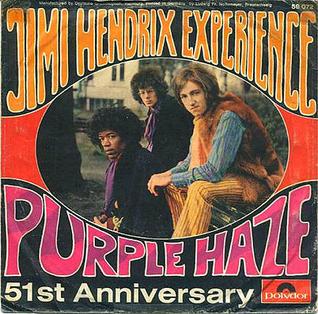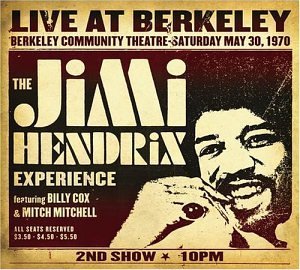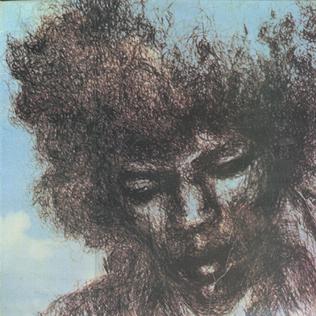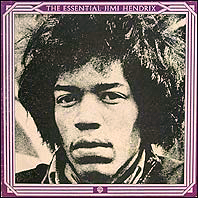Related Research Articles

James Marshall "Jimi" Hendrix was an American guitarist, singer and songwriter. Although his mainstream career spanned only four years, he is widely regarded as one of the most influential electric guitarists in the history of popular music, and one of the most celebrated musicians of the 20th century. The Rock and Roll Hall of Fame describes him as "arguably the greatest instrumentalist in the history of rock music."

"Purple Haze" is a song written by Jimi Hendrix and released as the second single by the Jimi Hendrix Experience on March 17, 1967. The song features his inventive guitar playing, which uses the signature Hendrix chord and a mix of blues and Eastern modalities, shaped by novel sound processing techniques. Because of ambiguities in the lyrics, listeners often interpret the song as referring to a psychedelic experience, although Hendrix described it as a love song.

Are You Experienced is the debut studio album by the Jimi Hendrix Experience. Released in 1967, the LP was an immediate critical and commercial success, and it is widely regarded as one of the greatest albums of all time. The album features Jimi Hendrix's innovative approach to songwriting and electric guitar playing which soon established a new direction in psychedelic and hard rock music.

Axis: Bold as Love is the second studio album by the Jimi Hendrix Experience. The album was first released by Track Records in the United Kingdom on December 1, 1967, only seven months after the release of the group's highly successful debut, Are You Experienced. In the United States, Reprise Records delayed the release until the following month. The album reached the top ten in the album charts in both countries.

Band of Gypsys is a live album by Jimi Hendrix and the first without his original group, the Jimi Hendrix Experience. It was recorded on January 1, 1970, at the Fillmore East in New York City with Billy Cox on bass and Buddy Miles on drums, frequently referred to as the Band of Gypsys. The album mixes funk and rhythm and blues elements with hard rock and jamming, an approach which later became the basis of funk rock. It contains previously unreleased songs and was the last full-length Hendrix album released before his death.

First Rays of the New Rising Sun is a compilation album credited to American rock musician Jimi Hendrix, issued in 1997 on MCA Records. Featuring songs mostly intended for his planned fourth studio album, it was one of the first releases overseen by Experience Hendrix, the family company that took over management of his recording legacy. It reached the album charts in the United States, United Kingdom, and four other countries.
Blues is a compilation album of blues songs recorded by American singer/songwriter/musician Jimi Hendrix. Compiled by interim Hendrix producer Alan Douglas, it was released April 26, 1994, by MCA Records. The album contains eleven songs recorded by Hendrix between 1966 and 1970, six of which were previously unreleased. Hendrix wrote seven of the pieces; other writers include Muddy Waters, Booker T. Jones, and Elmore James. Most are demos, jams, and live recordings, which Hendrix may or may not have completed for release.
"Voodoo Chile" is a song written by Jimi Hendrix and recorded in 1968 for the third Jimi Hendrix Experience album Electric Ladyland. It is based on the Muddy Waters blues song "Rollin' Stone", but with original lyrics and music. At 15 minutes, it is Hendrix's longest studio recording and features additional musicians in what has been described as a studio jam.

"Voodoo Child (Slight Return)" is a song recorded by the Jimi Hendrix Experience in 1968 that appears as the final track on the Electric Ladyland album released that year. It contains improvised guitar and a vocal from Jimi Hendrix, backed by Noel Redding on bass and Mitch Mitchell on drums. The song is one of Hendrix's best known; it was a feature of his concert performances throughout his career, and several live renditions were recorded and released on later albums.

"Machine Gun" is a song written by American musician Jimi Hendrix, and originally recorded for the 1970 Band of Gypsys album, with Billy Cox and Buddy Miles. It is a lengthy, loosely defined (jam-based) protest of the Vietnam War, and perhaps a broader comment on conflict of any kind.

Live at Berkeley is a live album by American rock musician Jimi Hendrix. It documents his second performance at the Berkeley Community Theatre on May 30, 1970, and was released by MCA Records on September 16, 2003.

The Cry of Love is a posthumous album by American rock singer-songwriter and guitarist Jimi Hendrix. Recorded primarily in 1970, it features new material that Hendrix was working on for his planned fourth studio album before his death later that year. While most of the songs were included on proposed track listings by Hendrix, the final selection was made by recording engineer Eddie Kramer and drummer Mitch Mitchell, with input from manager Michael Jeffery. Hendrix, Kramer, and Mitchell are credited as the album's producers, with Jeffery as the executive producer.

"Angel" is a song by American rock musician Jimi Hendrix, featured on his 1971 posthumous studio album The Cry of Love. Written and self-produced by Hendrix, he recorded it for his planned fourth studio album just months before he died in September 1970.
"Third Stone from the Sun" is a mostly instrumental composition by American musician Jimi Hendrix. It incorporates several musical approaches, including jazz and psychedelic rock, with brief spoken passages. The title reflects Hendrix's interest in science fiction and is a reference to Earth in its position as the third planet away from the sun in the solar system.

Crash Landing is a posthumous compilation album by American guitarist Jimi Hendrix. It was released in March and August 1975 in the US and the UK respectively. It was the first Hendrix album to be produced by Alan Douglas.
Midnight Lightning is a posthumous compilation album by American rock guitarist Jimi Hendrix. It was released in November 1975 by Reprise Records in the US and Polydor Records in the UK. It was the second to be produced by Alan Douglas and Tony Bongiovi and contains demo-type recordings that were overdubbed with musicians who had never played with Hendrix. Despite including reworkings of the popular live songs "Hear My Train" and "Machine Gun", the album was not as well received as its predecessor, peaking at numbers 43 in the US and 46 in the UK.

The Essential Jimi Hendrix is a compilation album of songs by American rock musician Jimi Hendrix, released in 1978 by Reprise Records. Some editions in the UK, Japan and Italy also contained a 7-inch 331⁄3 rpm one-sided EP single of the Jimi Hendrix Experience performing the song "Gloria".

The Essential Jimi Hendrix Volume Two is a compilation album of songs by American rock musician Jimi Hendrix, released in 1979 by Reprise Records. It is the follow-up album to The Essential Jimi Hendrix, released by Reprise the previous year.

Jimi Hendrix: An Illustrated Experience is a biography of American guitarist Jimi Hendrix, written by his stepsister Janie and his biographer John McDermott, and published on October 9, 2007. The book tells the story of Hendrix and his life through reproductions of rare material such as letters, drawings, postcards and posters. An Illustrated Experience also contains a companion CD entitled Hendrix: Live, which includes three live tracks, two interviews, and a studio jam entitled "Keep on Groovin'".
American guitarist Jimi Hendrix intended to release his fourth studio album as a double or triple LP before Christmas 1970. From June to August 1970, he made good progress on the realization of the planned album in his new Electric Lady Studios. Many songs were mixed on 20, 22 and 24 August. Four of these mixes were regarded as definitive versions and were presented at the opening party of Electric Lady on 26 August. Hendrix died on September 18 that year, leaving behind an enormous number of unreleased recordings in various stages of completion. It is impossible to know what Hendrix would have changed and what he actually would have released, but there is some documentation of the album configurations he had in mind. While a good part of the designated tracks only needed some finishing touches, others only existed as rough recordings and for some titles no recordings are known at all. The Cry of Love (1971), Voodoo Soup (1995) and First Rays of the New Rising Sun (1997) are officially released attempts to reconstruct the planned album. First Rays of the New Rising Sun is usually regarded as closest to Hendrix's vision, but features a track that was probably never part of Hendrix's plans and omits some tracks that were definitely considered. All but one of the tracks that are known to have been recorded for the album have eventually been released in some shape or other on official albums.
References
- ↑ "Jimi Hendrix's 20 greatest guitar moments, ranked". Guitar.com. 19 May 2020. Retrieved 23 January 2022.
- ↑ "Many cosmic returns". The Age . Retrieved 7 February 2022.
- ↑ Robertson, John; Doggett, Peter (2004). Jimi Hendrix: The Complete Guide to His Music. Omnibus Press. p. 31. ISBN 1-84449-424-1.
- ↑ Dove, Ian (26 September 1974). "'Black Gold,' New Hendrix In Old Tapes". Rollingstone.com. Retrieved 23 January 2022.
- ↑ "10 abandoned albums from legendary artists". Faroutmagazine.co.uk. 20 June 2021. Retrieved 23 January 2022.
- ↑ "Many cosmic returns". The Age. Melbourne. 12 March 2010.
- ↑ "Jimi Hendrix – Black Gold (1996, CD)". Discogs .
- ↑ "Black Gold". Hendrix.guide.pagesperso-orange.fr. Retrieved 23 January 2022.